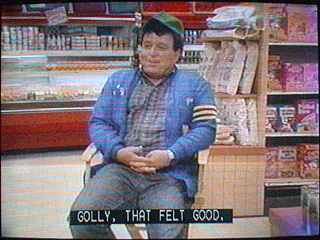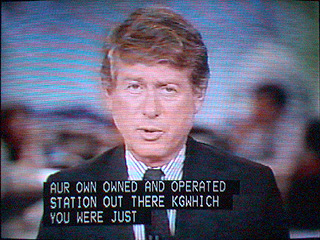 |
The Teletext Museum. |
|
|||||||||||
UNITED STATES OF AMERICA
By Ed Ellers
CBS had tested teletext in Los Angeles in 1981, and after the FCC approved teletext transmissions as a normal service in 1983 both they and NBC began teletext services using the North American Broadcast Teletext Specification (which was based on NAPLPS).
Panasonic and Sony marketed a few set-top decoders for the services on a very limited basis, only in those cities where stations had agreed to offer local teletext pages in addition to the network services; since the FCC did not mandate NABTS or any other standard some other providers could, and did, use the British WST system instead and in fact most of the hundreds of thousands of teletext TVs sold in this country (namely the Zenith Digital System 3 sets sold from 1986-1993) were built to receive WST. CBS and NBC preferred NABTS because of its ability to draw relatively complex shapes (such as network or advertiser logos) that WST can't handle (at least at Level 1), creating a stalemate that lasted until both networks gave up on teletext in the late 1980s.
Both NBC and CBS started teletext services in 1984, but the manufacturers (Panasonic and Sony) fumbled badly by only offering decoders in a few cities where local teletext pages were being added - not in the rest of the country. This used a very advanced system called NABTS, which meant that the decoders were far, far more expensive than in the UK.
 |
An off-screen example of an NABTS page from CBS' Extravision service, taken in 1984 |
Zenith had somewhat better luck when they included WST teletext decoders in their Digital System 3 sets from 1986-1993; these could receive a general service called Keyfax that was provided by Taft Broadcasting. This service was available nationwide except in the Atlanta area (since it was carried on the cable/satellite service of Atlanta superstation WTBS, but not its terrestrial signal).
There was also a service, whose name I've forgotten, that was available for a time piggybacked on The Discovery Channel. Unfortunately most owners of these sets bought them because of their attractive console cabinets or (in rare instances) because some models had Bose waveguide speaker systems, and so never worked up the curiosity to try teletext even though the feature was heavily promoted in the brochures for these sets.
The coup de grace came when the FCC mandated closed caption
decoders in most new TV sets starting in 1993; for various reasons it wasn't
practical to add that feature to the Digital System 3 chassis, so Zenith didn't bother to add teletext to the new chassis that replaced it. Because
of this utter lack of interest, the Keyfax service was discontinued in 1994.
There is, however, a teletext service of sorts that is currently available in North America; Gemstar, the VideoPlus+ people, have a service called Guide Plus+ that is available with most Thomson TV sets sold here over the past three years or so. It's mostly an electronic program guide, but also includes brief news items from MSNBC.
"Incidentally, the NTSC versions of most PC TV tuner cards have the hardware to support NABTS, so if these services still existed we'd be able to get them in the same way that WST teletext can be received by PAL tuner cards. The data transport portions of NABTS are very popular here for closed-user-group leased services and, more recently, for PC-based services like Intercast and WaveTop."
Here are some sample photos of captioning, text and other services transmitted using the North American line-21 system, variously known as CaptionVision or EIA-608.
Ed says "I had to shoot these off-screen (with a digital camera) because I don't have a working decoder that can provide a video output for screen captures, so the quality is not what I'd prefer -- the color banding is caused by a beat between the vertical stripes on the CRT and the diagonal striped filter in the camera."
 |
This is an example of typical "pop-on" captioning as seen on
prime-time entertainment programs. As with teletext subtitles, these pop on
as needed, then are either removed from the screen or replaced directly with
other pop-on captions.
This is a 1991 episode of Married...With Children. The actor shown here is best known for a character who was known to say things like "golly." :-) While this is the most professional type of presentation, it's also the most labor intensive and so is mainly used for prime-time programming and feature films. |
 |
This is an example of real-time
captioning, as used for newscasts (in this case, ABC coverage of the San Francisco earthquake in
October 1989).
Real-time captions scroll smoothly upward as each new line is sent, and are entered using a "Stenotype" shorthand keyboard often used by court transcriptionists. Since these captions are easier to prepare, they are also used for some taped programming such as soap operas where the extra cost and lead time of pop-on captions is not justified. The word "AUR" here should be "OUR;" this sort of error happens fairly often in real-time captioning. "KGWHICH" should read "KGO WHICH" - an error in decoding caused those two bytes to be lost. |
 |
This is another example of real-time captioning, this from
the 1989 World Series (just a few minutes before the previous picture).
The musical note is used to indicate that a song is being sung The >> characters indicate that a different voice is now being heard. The white block replaces a single character that was lost due to a data error. |
 |
This is an example of Extended Data
Services, which carry both program-related data and time of day information using the same
data format as closed captioning.
The chief application of this is for program ratings (the so-called "V-chip" system), which all new TV sets are required to be able to decode but which very few people seem to actually bother to use. It's also used by PBS stations to broadcast time signals that VCRs can use to set their clocks (as is done in the UK using teletext). Exactly how this is displayed is dependent on each TV set's design; this The first line (green) is supposed to
be the network name on the left and the local station's call sign and channel number on the right
- in this case it should have been "WLKY32," but the station (as with most stations) doesn't yet have XDS insertion gear
so the network's internal identifier ("NET2") is allowed to be seen. CBS'
own use of this is somewhat sloppy, so I have on occasion seen the (correct)
ident for their New York station ("WCBS 2") leak through on my local The second line (white, italics) is the program title; sometimes this The third (cyan) has the program length on the left, the program type in the center and the elapsed time on the right. Although not shown here, a short description of the program may appear (in yellow) in the bottom half of the screen, but at present only one channel I receive bothers to use this feature. |
 |
EIA-608 also includes a rudimentary text mode, which
allows up to four scrolls, 32 characters wide, to be displayed. (Some receivers, and the older set-top decoders, displayed sixteen lines on the
full screen, but most sets display only eight lines as seen here, and many
don't have the text feature at all.) This is not currently used anywhere
I'm aware of; this shot is from 1989 (again :-), when ABC and PBS broadcast
the Program Listing Update Service to inform deaf viewers of which programs
would be closed captioned that week.
Another service - operated from the early 1980s to the end of 1998 - was AGTEXT, from Kentucky Educational Television, which provided weather forecasts and market information to farmers. (AGTEXT was discontinued since the same sort of information is now obtainable easily on the Web.) |
Around the World index | Teletext in Europe
For
discussion about all aspects of teletext, from content right through
to complex technical matters.
If you have a question, this is the place to ask it...
![]()
mb21 by Mike Brown
![]()